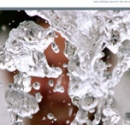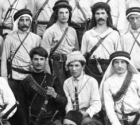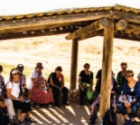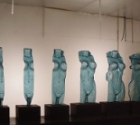
Japanese wedding
When we told our family and friends that we were off to Tokyo for a month, they all asked the same question. What on earth would we do there for so long and wouldn't we get bored? This would be my third trip to Japan, and on our previous visit which had allowed us only three days in Tokyo, we had been enormously impressed by the ever present contrasts of tradition and ultra modernity, serenity and unlimited energy, incomparably expensive and yet also affordably cheap. The idea of "living" there for a month as we had done in the past in London, New York and Paris, was appealing, but, I feared, also prohibitively expensive. Through the internet, I checked the cost of short term furnished apartment rental and to my surprise found a studio apartment in a great area, Harajuku, at a very affordable price. There are no direct flights to Tokyo but Korean Air now flies to Seoul, from where a short connecting flight gets you to Tokyo. The cost of the ticket on Korean Air was substantially cheaper than what I remembered paying on our previous visit. Things were looking good.
I booked and paid for the apartment through the internet, which left me with the feeling that this could well be a scam and that we might arrive in Tokyo and find ourselves both without accommodation and out of pocket of a month's rental. A train from the airport to Shinjuku station and then a short taxi ride using GPS brought us to a small street where our taxi driver informed us that we had arrived. Most Tokyo streets don't have a name and so finding an address can be complicated. I called the flat owner on the phone and within a few seconds he appeared at the door of the building next to us. I had forgotten how small Japanese apartments can be. A bathroom, separate toilet, kitchen and a bedroom/lounge with an extension of another half room. All small but well fitted out with everything we would need from a washing machine and dryer to umbrellas and dishcloths. The apartment was wonderfully situated less than a kilometer from eight different train stations, each on a different line, thereby allowing us to get to almost any part of Tokyo without changing trains. In addition, there was the "Community Bus" stop at the door of our building which for a dollar took us to the nearby train stations. Sometimes we used this bus, but most often enjoyed walking through the small streets that took us to our station of choice for the day, each time finding a new route or seeing something that we had overlooked on the previous walk.
Tokyo has no real center, but is rather like a number of towns joined together with each area having a specific character and center of gravity. We stayed in Harajuku, the fashion center of Tokyo, where the wealthy look for the latest in fashion on Tokyo's Champs Elysees, home to the amazing collection of Japanese designer Issey Miyake and to the glass bubble building of Prada. Nearby, the younger generation shop in their thousands along a five hundred meter, jam packed, stretch of pedestrian mall, looking for some article of clothing or accessory which will allow them to stand out and be noticed. Harajuku is also home to the biggest park in Tokyo, where some of Tokyo's homeless have built a blue plastic tent town under the trees, and the constant chuck-chuck-chuck of drink cans being hammered flat told us how they earn their living. Come here too to visit the most important Shinto shrine in Tokyo, which, with its constant stream of traditionally dressed brides and grooms, offers a not to be missed photo opportunity. The nearby museum of wood block prints was one of our favorites, giving a glimpse of life in days gone by.
Nearby is Shibuya, with the busiest crossing in the world, where I felt that every time the traffic light changed and the thousands of pedestrians crossed in every direction, their generated energy would lift me off my feet and carry me across the road. From late afternoon, the surrounding streets and alleys are packed with people visiting the restaurants, shops and love hotels that can be found not only at street level shops but also in the upper floors of the many high rise buildings. At a guess I would say that Tokyo has more restaurants than any other city in the world. An entire building may have half a dozen different restaurants on each floor, while in some areas every second shop is a restaurant.
Tokyo was almost entirely destroyed during WW 11 and very few old buildings of any interest still exist. Some of these have been rebuilt in a park in western Tokyo where one can get an idea of how shops and houses looked a hundred years ago. Modern architecture, however, is at its best in Tokyo and we spent many enjoyable hours looking for and at spectacular buildings, ranging from art museums to shopping malls to convention centers and office blocks. Tokyo Midtown is the most amazing shopping mall and office block I have ever seen, and besides its shops, it has art museums, a park with outdoor sculpture, and other relaxation areas. The tens of restaurants offer every type of food and the shop windows are spectacular, displaying goods from square watermelons to the latest gadgets for the man who has everything.
A visit to the Japanese war museum was a wonderful opportunity to see how the Japanese saw WW11. The bombing of Pearl Harbor was only the last of a number of aggressive acts carried out by the Japanese on its Asian neighbors during the preceding seventy years or so. Knowing Japan's policies today, I had hoped that the museum would lead one to conclude that war was bad and show its resultant suffering. Thus, I was both surprised and disappointed to see that they see themselves as having had no alternative and that the West, due to its cutting off of supplies of raw materials to Japan, was the trigger which resulted in their bombing Pearl Harbor.
We spent almost one entire day at a Sumo competition which in days gone by was part of a religious ceremony. These competitions are held three times a year in Tokyo and each one carries on for 15 days. As the day progresses, the ranking of the competitors increases, so that from about four o’clock in the afternoon all of the bouts are between the top 15 wrestlers in the world. These gigantic men dressed in a sort of g-string belt, who appear to be so fat that they have difficulty in walking, are the day’s highlight. Before they begin to fight each other, they huff, puff and stamp in an effort to intimidate one another. In the ring they are supple, fast and enormously strong. While the bouts themselves are both interesting and exciting, resulting in the crowd roaring encouragement and throwing cushions into the air, the actual fight is only a part of the entire ceremony. The crowd, the arena, the extravagant costumes worn by the judges, the little man who sweeps the ring, and the caller who announces the following bout, all add to the grandeur of the day.
Although none of Tokyo's gardens are ranked in the top three in the country, we found all of them both beautiful and peaceful and made an effort to visit as many as possible. The traditional tea house, the lake, the delicately pruned trees and stone lanterns give one a sense of peace and harmony in such blatant contrast to the traffic and masses of people outside its walls.
One evening we caught the train to a temple in the suburbs where we took part in a Buddhist festival. People paraded through the streets carrying lanterns, beating drums, dancing and praying. The youngsters, as on Yom Ha'Hatzmaut in Israel, were chatting and laughing with their friends and the hundreds and hundreds of food stalls were busy supplying octopus balls, baked potatoes, okynomiyaki (a giant pancake with meat and vegetables), and any and all other Japanese take-away foods, so that, none of the tens of thousands of people taking part, should be hungry.
A visit to "Hands", an enormous ten storey shop, selling every conceivable thing related to every conceivable hobby, fulfilled two functions for us. Firstly, it kept us busy for an entire day and secondly, it helped us to make a significant contribution to the Japanese economy. Shopping, generally, in Japan is different from anywhere else. One never has the feeling that in order to make a sale, people will tell you what they think you would like to hear. They are honest and helpful to an extreme. In one gigantic department store, at the request of our daughter, we were looking for sewing patterns. After much effort by the entire staff of the material department to understand what we wanted, and then an animated discussion amongst themselves, the manager of the department informed us that they didn't stock patterns, but sent one of the women (a lady of about 50) to take us to a shop where they knew that they did. A ten minute walk later we arrived at the little shop, whereupon the accompanying saleslady thanked us, bowed and went back to the department store.
Honesty in a city Tokyo's size is not something to be taken lightly. One evening we were sitting at an outside table at a Starbucks coffee shop, on a promenade leading from Shinjuku station, supposedly the busiest station in the world, thousands of people hurrying to and fro. Four young women came to an empty table near us, left their bags unattended on the table and went inside to order and wait for their drinks. (In contrast to both Peru and Bolivia where the waiters chain your bag to your chair).
Video games are another ten storey building type business. Most of the players are men in the twenties and thirties but one floor had booths for watching DVDs. This was for women only. A few friends rent the DVD together. The women, mostly teenagers and early twenties, each choose a fancy dress costume, dress up and then go into the booth together to watch the movie. Strange. In adjacent buildings one can visit a "Maid Cafe" where the waitresses are dressed up as maids. Little black dress with white apron, small white cap, black stockings and exceptionally high heeled shoes. One pays a cover charge for the service and in some places there are additional "services" costing additional fees.
For me, one of the highlights of any holiday is the opportunity to experience the country’s cuisine and I spent hours preparing a list of which restaurants I plan to visit. I am not really sure why I do this, as the list was left packed in the suitcase. In Tokyo finding a restaurant by address is especially difficult unless one takes taxis (which are expensive) and so, as usual, we either ate at places that we came upon by chance or that were recommended by our guide book where the directions were always accompanied by a map. The myth of Japan being expensive is nowhere more evident that where eating is concerned. Yes, it's possible to eat for hundreds of dollars a head, but somewhere around $10 for lunch and not much more at supper will easily get you a three course meal at many restaurants. For those on an even tighter budget there are thousands of fast food restaurants - noodle soup with additions of fish, meat or vegetables, or rice topped with meat and gravy. The cheapest way to eat is to visit the magnificent food halls found in the basements of the department stores where they offer free tastes of various delicacies.
We spent some days discovering the out of the way temples and little visited museums listed in our walking tours of some of the less known suburbs, much the same kind of thing that we would do with a walking tour guide book of Tel Aviv or Jerusalem. We met Tokyoites doing the same tours of their own city and ate at those special little places that "only the locals" know about. We felt Japanese. Well, almost.
The month was over too quickly and we left Tokyo with a feeling that it would be great to come back for longer. Maybe for a year when we retire when we could come to teach English.
 DEAR EDITOR 153
DEAR EDITOR 153 REVISITING THE PAST BETH HASHOMER
REVISITING THE PAST BETH HASHOMER BIBLICAL ZOOS & ANIMAL RESERVES IN ISRAEL
BIBLICAL ZOOS & ANIMAL RESERVES IN ISRAEL From Bible to Bedouins and Battles
From Bible to Bedouins and Battles Trip to the Dead Sea
Trip to the Dead Sea Japan
Japan Brian Braude
Brian Braude